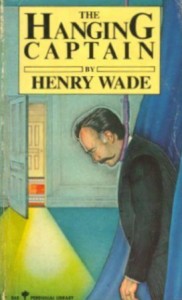The Hanging Captain by Henry Wade
Review by Matt B. (BuffaloSavage)
In this classic English detective story from 1932, an unlikable captain is found hanging in his library. The Chief Constable dubs it suicide in order to make the affair go away. But a professorial outsider proves the captain was murdered. The two local detectives brought in on the case are the impetuous veteran Detective-Inspector Herbert Lott and his rival to the promotion of Chief Inspector, the dully logical plodding Poole.
There are numerous suspects, as becomes a Golden Age mystery. Thus, a plethora of alibies must be checked, intricate time tables constructed, and lor’ love a duck, there’s even a floor plan of the country house. What distinguishes this from the comfy atmosphere of Sayers and Allingham is the possible motives for the murder are quite bold, adult and shocking enough that I can’t in good conscience give them away in a review. Wade is less warm and bleaker than most Golden Age writers.
Wade wrote as many as 22 detective novels or story collections between 1926 and 1957. This one and Mist on the Saltings were published by Harper Perennial in a series of great re-issues in the Eighties. In their reference book Catalogue of Crime, Barzun and Taylor said about Wade: “Though insufficiently known in the US, Wade is one of the great figures of the classical period. He was not only very productive bit also varied in genre. His plots, characters, situations, and means rank with the best, while his prose has elegance and force.”















